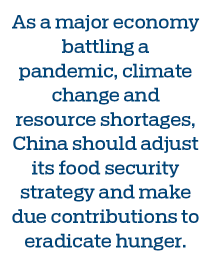Grains of truth

Pandemic has shown China needs to reform its food security policy by focusing on domestic production and using international imports as supplements
In early 2021, there were some flare-ups of novel coronavirus infections in China. Unlike the outbreak last year in Wuhan, capital of Hubei province, four new characteristics were noticed this time: imported cases, cross-province transmission, spread in both rural and urban areas and unexpected outbreaks. Some of the recent cases have exposed the potential danger of virus transmission through the food supply chain and the urgent need to look at food security strategy in the post-pandemic era.
First, China should shift to domestic food production and reduce its dependence on imported food.
If the pandemic persists for a long time, China's food supply and trade will suffer.
The latest World Health Organization report shows that the virus has infected more than 100 million people worldwide, and major food exporters to China, such as the United States, Brazil, Canada and several European countries, are among the countries hardest-hit by the virus.
According to China's customs administration, China's accumulated food imports in 2020 were more than 142 million metric tons and its soybean imports in 2019 accounted for 58.33 percent of the total global soybean trade.
With the virus still not under control in many countries, the cross-border food trade may play a part in spreading the virus through the cold chain. Besides, quarantine and lockdowns inevitably disrupt food production, processing, circulation and trade, crippling global food supplies and trade.
Therefore, China should reform its food security policy, focusing on domestic production while using international imports as supplements. On the one hand, it needs to reduce the import volume and adopt a safety monitoring mechanism for imported food by leveraging certified safe and green supply bases, data-sharing networks and updated logistic information. On the other hand, it should increase research and development for higher productivity, reduce waste, lower costs, and maximize the stability, efficiency, safety and sustainability of domestic production to make up for the reduced imports. Building an extensive logistics network of production, storage, processing and distribution will minimize food loss, while promoting healthy eating habits and thriftiness among urban and rural residents will reduce food waste.
Second, China should tune in to the north-south reverse in food production and consumption.
Ever since the northern part of China overtook the south in grain production in 2005, the north and the south have reversed their roles. The north, traditionally the receiver, has become the major supplier. Its percentage in total grain output has jumped from 55.39 percent in 2010 to the current 58.45 percent in 2018, while that of the south has declined from 44.61 percent to 41.55 percent. However, the south is the production base for fruits, aquatic products, and processed foods. The north-south division of food production has led to a high dependence on domestic logistics. According to data from the National Food and Strategic Reserves Administration, most inter-provincial food logistics opt for rail and water transportation, accounting for 50 percent and 40 percent of the total, respectively. However, pandemic containment measures, such as quarantines and city-wide lockdowns, hamper food logistics. Longer hours during shipment and shrinking shipping volumes will significantly increase transportation costs and jeopardize food security.
In the uphill and long-term battle against the pandemic, rebalancing the north-south division of food production is necessary. Specifically, the north should put a brake on its runaway grain production. It should adopt green and sustainable production methods, reduce the consumption of water and soil, step up local food processing and reduce long-distance transportation. The south should improve its grain production to wean itself off northern grains and streamline intermediate food distribution chains to minimize the transmission paths for the coronavirus and other pathogens.
Third, China should ensure safe food production and supply for large cities and its hinterlands.
The pandemic has hit food supplies to populous areas, especially large cities. Inadequate supplies, traffic controls and impeded access in lockdowns and staff shortages resulting from quarantining have led to higher logistics costs and the soaring prices of fresh agricultural products.
After four decades of rapid urbanization, China has a number of megacities of over 10 million people. These densely populated cities, such as Shanghai, Beijing, Guangzhou and Wuhan, need to establish their own vegetable supply bases to ensure they have a basic supply in an emergency. In the post-pandemic era, the megacities should increase public spaces, such as parks and green belts, to serve as emergency shelters or even makeshift bases for distributing vegetables.
The recent resurgence of the virus in some parts of China has exposed the great uncertainties in global food supplies and flaws in the current Chinese food security strategy. As a major economy battling a pandemic, climate change and resource shortages, China should adjust its food security strategy and make due contributions to eradicate hunger.


The author is a professor of the College of Land Science and Technology at China Agricultural University.





















